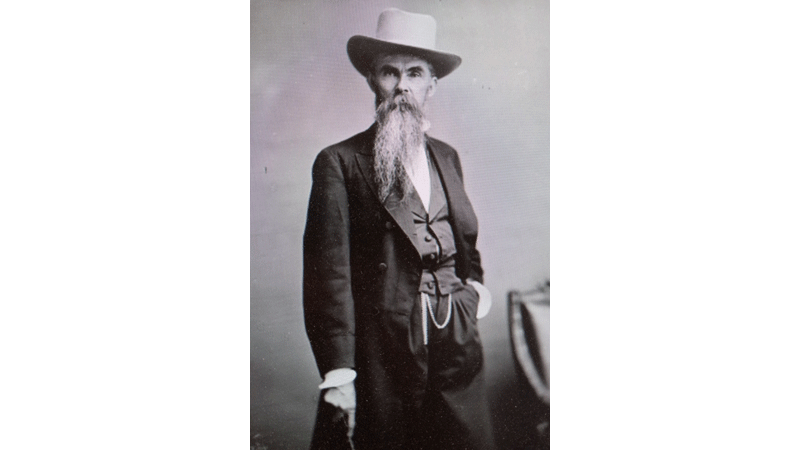History of William Mahone
Published 11:12 pm Wednesday, January 25, 2023

- In 1854, while still involved with development of the Norfolk and Petersburg Railroad, William Mahone designed what was to become the town of Ocean View — on the Chesapeake Bay. (Photo submitted by Clyde Parker)
|
Getting your Trinity Audio player ready...
|
OCEAN VIEW
Many people who look back at Virginia and Southampton County history think of William Mahone (1826-1895), of the Monroe community in Southampton County, Virginia, as the general who was a major force for the Confederacy during the Civil War. But he was much more.
First of all, yes, he was a Major General who was quite a lot involved with the Battle of the Crater at and near Petersburg, Virginia. And, he was the principal organizer of the Norfolk and Petersburg Railroad (later known as Norfolk and Western, still later Norfolk Southern. And, following the Civil War, he served as Mayor of Petersburg, was a Virginia state senator, served in the Virginia House of Delegates, and served a term as a United States Senator. He was a member of Readjuster Party.
A more obscure William Mahone involvement was the fact that he was connected with Ocean View on the Chesapeake Bay. The area that was to become known as Ocean View was a part of Norfolk County for over 225 years, until it and the adjacent Willoughby Spit area were annexed by the independent City of Norfolk in 1923.
A little-known thing about William Mahone is the fact that in 1854, while still involved with development of the Norfolk and Petersburg Railroad, he designed what was to become the town of Ocean View – on the Chesapeake Bay. The area that later became known as Ocean View City, originally, was a 360-acre tract called the Magagnos Plantation. Mahone surveyed and laid-out streets and lots as Ocean View City. At that time, he was a young civil engineer, having graduated from Virginia Military Institute, class of 1847, with a degree in civil engineering.
About 30 years later, some time around 1880, Walter H. Taylor, a railroad executive from Norfolk, organized a nine-mile-long narrow-gauge steam passenger railroad service between downtown Norfolk and Ocean View. The railroad crossed what was then called Tanner’s Creek – later renamed Lafayette River. Originally, the line was called the Ocean View Railroad; but, a little later, it was changed to the Norfolk and Ocean View Railroad. A small steam-powered locomotive named the “General William B. Mahone,” hauled passengers from Norfolk to Ocean View Beach, primarily on weekends and Sunday outings. Later, the steam-powered locomotive was replaced by electric-powered trolley cars.
During the early 1880s, Ocean View was becoming both a popular resort and a streetcar suburb of the City of Norfolk. Initially, the destination consisted of a swimming beach and just a few cottages. The location was quite popular for Sunday outings by people from Norfolk.
With the advent of additional electric streetcars in the late 1880s, an amusement park was developed at the end of the line and a boardwalk was built along the adjacent beach area. During the 1920s, and later, Ocean View was a favorite of sailors on leave from the Norfolk Navy Base.
In 1928, the popular Nansemond Hotel was built; It became a well-known national and iconic landmark. It was lost to fire in 1980
In the late 1940s, buses replaced the streetcars. Ocean View continued to be a very popular escape destination for Norfolk citizens. It was Norfolk’s resort. The beach at Ocean View was quite nice. Over periods of time, additional cottages were being built.
The amusement park was called the Ocean View Amusement Park and was famous for its landmark wooden-structured roller coaster, “The Rocket.” In the mid-20th century, for a number of years, AM radio station WGH broadcast live from a booth under the roller coaster.
After years running, the Ocean View Amusement Park closed after Labor Day in 1978. Soon after, in 1979, the vacant amusement park was used to film the movie “The Death of Ocean View Park,” which featured the blowing up of the landmark wooden roller coaster structure; however, it would not fall down after various attempts with explosives. Finally, after the third try, a bulldozer off-camera had to help pull the structure down to capture the shot for the film.
Not only was the amusement park well known to the region and beyond, so was Harrison’s fishing Pier. For a long period of time, it was owned by Bill Harrison and managed by Charlie Woodard. It was heavily damaged during Hurricane Isabel in September 2003. A new 1,690-foot pier was built called the Ocean View fishing Pier.
Ocean View is noted for its annual St. Patrick’s Day parade. It was started back in 1967. Called one of Norfolk’s most enduring and anticipated traditions, it is one of the largest St. Patrick’s Day parades in the country.
Legend says that Ocean View’s Willoughby Spit was created by a hurricane. The area known as Willoughby Spit is named after Thomas Willoughby, who came to Virginia in 1610 and received various land grants in 1625. It is said that Willoughby’s son, Thomas II, was living there in the 1660s when his wife awoke one morning following a terrific storm to see a point of land in front of her home which had been covered by water just the night before.
In the present-day, Ocean View is considered a significant part of the City of Norfolk. In more recent times, the East Beach neighborhoods have greatly contributed to and enhanced the overall development of the area that we still call Ocean View.
CLYDE PARKER is a retired human resources manager for the former Franklin Equipment Co. and a member of the Southampton County Historical Society. His email address is magnolia101@charter.net.





